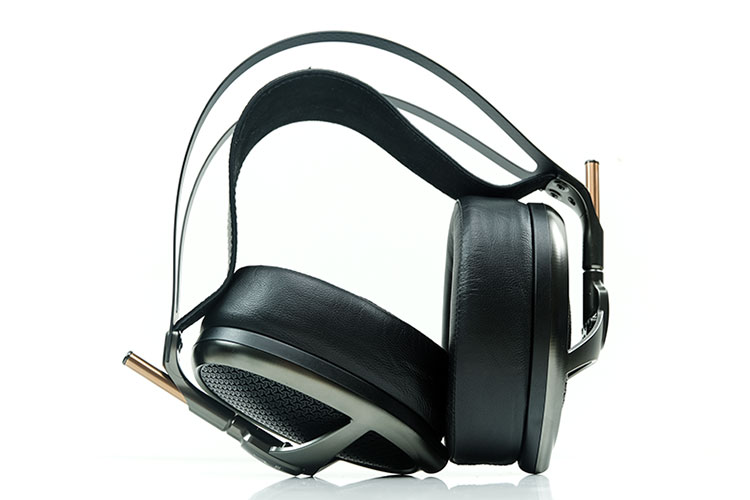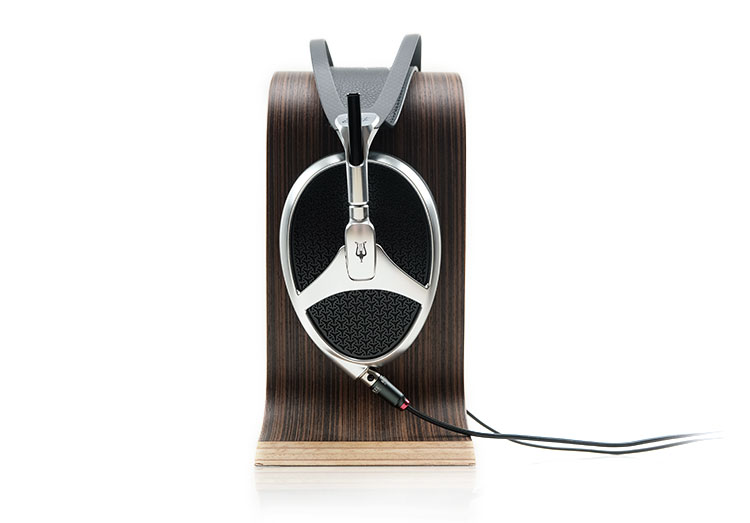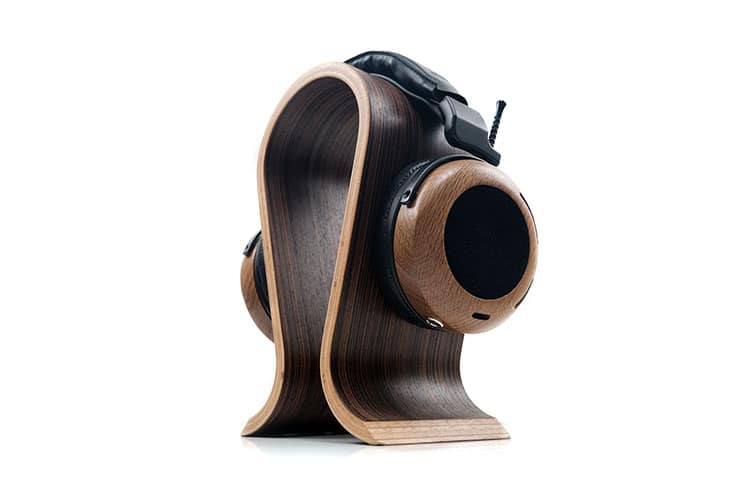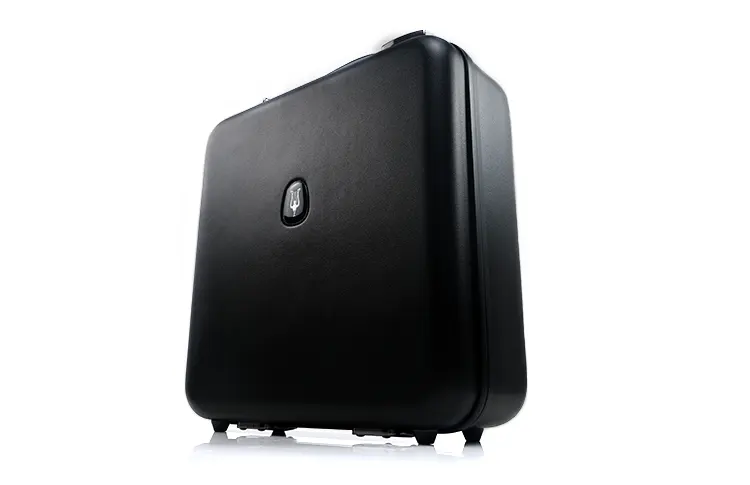Select Comparisons
The following comparisons to the Meze Audio Empyrean II were made using a mix of the HIFIMAN Prelude, dCS’s Lina Network DAC/Headphone amplifier, and the Holo Audio Spring 2 Wildism Edition DAC.
Meze Audio Empyrean
The original Empyrean was launched in late 2018 with our review following shortly in early 2019. We rated this one highly at the time and won our Top Gear 2019 Best Headphones award alongside the Abyss Headphones Diana Phi.
Technical
Both the original and Empyrean II share the same MZ3 Isodynamic Hybrid Array Driver with the dual individual switchback and circular trace design.
For the Empyrean II version, the internals got a new acoustic mesh to the front, and an acoustic damper to the rear, as well as an updated treatment process for the driver membrane to give it a bit more rigidity. As a result, it sounds audibly different from the original.
The second key aspect of the tuning is the new Empyrean II pads. They have always formed an integral part of the driver efficiency and tuning process since the original and it is no different here.
The perforated hybrid Duo formulation is a halfway house between the original non-perforated leather pads and the original Alcantara pads. The new angled velour pads are more open-sounding than the original deeper non-vented Alcantara pads.
One last technical observation is the sensitivity of the two headphones. Both of these headphones are quite efficient at 32Ω but the SPL on the Empyrean II has had a bump going from 101 dB to 105 dB SPL @ 1 kHz, 1 V.
I honestly felt the original sounded a tiny bit more sensitive paired with the HIFIMAN Prelude but it may be psychoacoustic with the leather pads creating a more intimate stage than the Duo pads.
Design
These headphones are identical in terms of articulation and form factor.
The only major differences are in the grill patterning, the new earpads, and the finishing on the Empyrean II which is now a lower-profile matte black with silver accents as opposed to the gunmetal and bronze from the original.
I do not have a preference either way for which particular color I prefer. I think both look fantastic but I do think both have a slight edge over the older silvery finish of the Elite which was recently changed to Tungsten. Again, just a personal preference.
The new grill design does look more intricate and you can tell there is a lot of work done to get that fine detail in without messing up the concept.
Both headphones share the same mini-XLR connector system. That is a feature of all of these Meze Audio high-end headphones.
I am pleased to see that both the silver-plated PCHUD cable and the copper choices do not add anything to the final price at the checkout. They are both good quality cables with the copper slightly attenuating the treble forcefulness compared to the SPC which might appeal to those sensitive to stronger treble peaking.
A bigger more welcome change away from the older headphones is that new carry case for the Empyrean II. Its styling is more in tune with the headphone design and its more compact form factor is easier to manage than the older wider case of the original.
Performance
In their stock format with the leather and duo pads, the Empyrean II sounds very different from the original tuning.
The OG Empyrean has a more elevated bass shelf beyond the mid-bass up to 300Hz and even beyond up to 1k it shows more elevation in its presence here also compared to the flatter FR of the Empyrean II over the same region.
As a result, the Empyrean II is more neutral in its tuning, with more bass/treble contrast. It also has enhanced energy in the upper mids/highs compared to the older version. The mid-timbre is cleaner sounding and lacks the euphonic-rich timbral warmth of the original.
That cleaner tone will allow you to pick up a lot more micro-detail and nuanced imaging in the background giving you a stronger perception of a more complex soundstage and better resolution.
The older version is darker, especially over the lower treble and thus dulls down the micro-detail and will sound comparatively smoothed over and less revealing.
Arguably, though it’s also more forgiving, especially for higher-pitched vocals and percussion bright mixes. The Empyrean II is a little leaner over the highs and less forgiving in that respect.
With both using the angled pads, the Empyrean II sounds more articulate and open with a lot more perceived headroom and treble energy. It does sound brighter and more mids to highs focused than the original version using the older Alcantara pads.
If we are talking purely timbre for the Alcantara pads I might actually prefer the original but if you want a more complete technical performance then the Empyrean II/angular Alcantara pads are a better choice.
Pad Swapping
For original Empyrean owners worried that the new more neutral tone is not for them then I suggest you swap to their V1 all leather pads because it does raise the bass shelf of the Empyrean II quite significantly and is closer to the first version’s tuning for the lows.
You can further enhance that perception by choosing the copper cable which pulls back on the treble presence a little more compared to the SPC cable.
That being said, you will not get a duplicate of the old tuning with these changes but rather it brings you closer. You can still tell that the driver has been tweaked for more headroom on the highs and still sounds clearer and more open through the mids.
Meze Audio Elite
The Meze Audio Elite was launched in 2021 and represented a slight shift away from the Empyrean sound signature. It is currently Meze Audio’s flagship headphone, (price-wise).
Technical
The Elite uses a different driver to the Empyrean II called the MZ3SE with a diaphragm design called Parus®. This design uses a semi-crystalline polymer film instead of the Empyrean II’s polymer to achieve a lower-mass acoustic diaphragm.
The unique dual individual switchback and circular traces on the coil remain the same for both headphones as also the symmetrical placement of the neodymium magnets around the driver and the detachable ear pads with additional magnets inside that form part of the final tuning and performance.
If you are wondering where the angled Alcantara pads from the Empyrean II come from, then it’s from the Elite Tungsten package. These are shallower than the older Empyrean Alcantara pads at 25mm compared to 30mm and angled as opposed to uniform.
The Elite, however, does not come with the Empyrean II’s new Duo pads. Instead, it uses a different more conservative hybrid formula of perforated Alcantara on the inside wall, and leather on the outer wall. All of this does have an easily identifiable effect on the sound signature when swapping the pads around.
On paper, the Elite is rated on the mW scale as opposed to Vrms at 101 dB (1 mW / 1 kHz) compared to the Empyrean II’s 105 dB SPL @ 1 kHz, 1 V.
In short, the Empyrean II is less sensitive compared to the Elite and requires a little more juice on the dial to match. Both share the same 32Ω efficiency rating.
Design
This is a trickier one to compare as the Elite aesthetic has changed since I did the original review. Instead of the silver frame with black grills, pads, and carbon fiber headband, the Elite now comes in Tungsten with a darker Cerakote™ finish for a more textured finish.
I would say from looking at the new design pictures, that the new Elite looks a lot closer to the Empyrean II aesthetic than the older silver version, which is my least preferred finish to the three high-end headphones from Meze.
Both the old and the new Elite still sport the older Empyrean mesh grill design and here again, I have to say the new grill design on the Empyrean II looks more intricate and comes out a bit bolder-looking in our pictures also.
Aside from that, both headphones function in the same manner and with the same form factor save with both very comfortable to wear.
There are also no differences in the choice of cable and the mini-XLR connection system with both the Elite and the Empyrean II coming with either copper or SPC PHCUD cable options at no additional charge.
Performance
The tricky thing about the Elite, (stock hybrid pads), when stacked up against the Empyrean II, (stock Duo pads), is that it has a less extreme level of coloration compared to the original Empyrean.
Despite its step-up in technical and staging capability, the tuning has less of a clear-cut contrasting sound when compared to the Empyrean II. You could argue it sits somewhere in between the two Empyrean headphones tonally.
Thus, the Elite is still colored, still warmer sounding than the Empyrean II, but has a lighter touch than the original, with more headroom, improved clarity, and tighter on the lows.
You will notice also that its bass shelf is also more extended than the Empyrean II carrying more warmth and body up into the lower mids.
The Empyrean II is more neutral over the same range with less lower midrange weight but where I think it has an advantage is that it does not dip as far down below neutral through the rest of the midrange compared to the Elite.
We are talking about 2k onwards where the Empyrean has more presence throughout which not only gives all higher pitching instruments a bit of a lift but improves on the perceived clarity through the mids and highs.
The Elite can seem somewhat congested and less distinct over the same range so I was having a harder time with retro-style warm recordings of the type recordings in small spaces with a lot of tube-amplified thick Les Paul guitar sounds and male vocals.
The Empyrean II’s cleaner sound worked better for me on these recordings in terms of separation and vocal presence. The downside of this is the enhancing peaking on the lower treble of the Empyrean II can be more noticeable on brighter recordings or percussion-heavy tracks.
ZMF Headphones Caldera
The ZMF Headphones Caldera was launched in late 2022 with our review at roughly the same time. It was awarded our Top Gear Best Headphones for the same year.
Technical
Both headphones are open back with planar magnetic drivers and a dual-sided N52 (Neodymium) magnet implementation.
The Caldera uses an 80mm planar driver as opposed to the Empyrean II’s ovoid 102 x 73mm dimensions with a larger active surface area at 61mm compared to 46.5mm.
It is custom-designed with 4 traces and 8 pathway patterns made of gold-plated copper rather than aluminum. I presume, however, that the Caldera voice coil or trace pattern is more uniform whereas the Empyrean II’s uses the dual individual switchback and circular coil design.
The magnet arrangement approaches also diverge with the hybrid symmetrical nature of the Empyrean II arrays contrasting with what ZMF called CAMS. This stands for Caldera Asymmetrical Magnet Structure and is a dual-sided trapezoidal-shaped N52 Neodymium magnet array.
Both are designed to produce the same outcome though and that is to keep the tension on the diaphragm as uniform as possible over the entire surface.
The approach to airflow differs with the new grill venting design being one aspect Meze worked hard on with the Empyrean II. The Caldera has something quite different with the Atrium damping system, (ADS).
This is a spongy-looking angular construction on top of the driver focusing on enhancing pressure uniformity and reducing back-wave cancellation.
Both companies do take pads seriously. Whilst not as integrated with the driver magnet array as the Empyrean II pads, the Caldera comes with multiple pad options that affect final tuning.
The Caldera is less efficient than the Empyrean II at 60Ω compared to 32Ω and with an SPL of 95dB/mW as opposed to the Empyrean’s Vrms benchmark of 105 dB SPL @ 1 kHz, 1 V. Testing on the balanced output of the Prelude, I felt the Caldera just a little bit harder to drive but not a huge gap.
Design
I suspect if you talk about headphone designs both Meze and ZMF would be among the top two brands on the tip of your lips but for differing reasons.
The Caldera is very much a ZMF creation with its focus on wood and the Empyrean II form and aesthetics carries on from the success of the original Empyrean. Both are very different but both with huge aesthetic appeal to their audiences.
Objectively, the Caldera is bigger and heavier at up to 550g compared to 455g (with duo pads) and you will notice that difference when handling them or wearing either.
However, I must say the pressure distribution on both headphones is very good. Aside from the slight increase in vertical pressure from the Caldera, neither is going to give you any long-term discomfort.
The Empyrean II has the edge for lateral comfort with the Alcantara Duo pad surface making them a little comfier than the firmer Caldera leather pads though you can change those pads to velour which will give you a softer fit also.
No question that the engineering application to both the articulation and refinement of the Empyrean II parts is slicker than the Caldera’s frame. The cup lateral movement and adjustment are smoother and ahead of the more traditional notch rod application of the Caldera.
Both are terminated with mini-XLR and here again, the Empyrean II cable choices and finishing are just a step higher. The Caldera cable’s braided nylon finish is quite nice just not as polished looking as the Empyrean II SPC or copper cable choices.
Performance
The Caldera has a more natural tone with less contrast compared to the Empyrean II. It does have a slightly relaxed midrange, but it’s not as v-shaped as the Meze tuning.
The Empyrean II’s bass shelf is higher along with a more aggressive dip into the mids whereas the Caldera low-end is very linear up to around 800k. That means there is a bit more presence and body around 50-100Hz from the Empyrean II, but that weight doesn’t travel up into the mids because of the progressive drop to 1k.
The Caldera bass retains a nice degree of warmth and presence right up to 1k, so whilst not as colored on the low-end, it retains an excellent body and a fantastic fundamental for instruments that pitch in the lower-mids.
Both are relaxed around 1-2k, and both have some natural bumping around 2-3k for vocal presence, however, the Empyrean II retains a lot of energy beyond whereas the Caldera keeps it more muted around 4-5k with some gentler peaking around 8k.
That gives the Empyrean II a cleaner sound with more odd harmonic emphasis, especially through the 3-6k range. Attack and decay will sharpen and shorten giving it a stronger perception of speed whereas the Caldera flows with a slower but more natural and evenly balanced tone.
For staging capability, it’s all about the reverb for me. When reverb plays out on tracks you can hear it dissipate into the air on the Caldera and whilst the Empyrean II’s does very well here you can hear it just cut off a little earlier.
The Caldera staging plays out more like a large hall whereas the Empyrean II is a large room. You can enhance the air and space from the Empyrean II using the angled Alcantara pads but at the cost of the Duo’s better depth.
Our Verdict
The Meze Audio Empyrean II takes a huge chunk of what made the original Empyrean so good such as looks and comfort and integrates a new sound signature that should appeal to a much wider audience than before.
That means improved tonal accuracy, a more spacious and revealing soundstage, and excellent extension into the highs. The new pads bring a mix of balance and power or focused clarity and space depending on your preferences.
Hardcore original Empyrean owners might tread cautiously into this new world. I get that, I have both and they do sound very different. My biggest tip is to grab the stock copper PCHUD cable and a smooth-sounding amp to bring you through the gate safe and sound.
Like the original, you do not need a demanding amp. They still run like a boss from a very wide selection of portable and desktop gear. Some will push the highs a bit more and others will deliver a deliciously laid back richer tone.
Matching will still play an important role here but it will not take a huge amplifier to drive these excellent-sounding headphones.
Meze Audio Empyrean II Specifications
- Driver Type Rinaro Isodynamic Hybrid Array Driver
- Enclosure Open-back
- Ear Coupling Circumaural
- Frequency Response 8 – 110,000 Hz
- Impedance 32 Ω
- Sensitivity 105 dB SPL @ 1 kHz, 1 V
- Maximum SPL >130 dB
- Total Harmonic Distortion (THD) <0.05% @ 1 kHz, 1 V
- Weight 385 g (without earpads)





